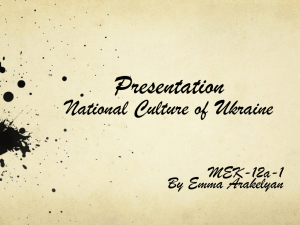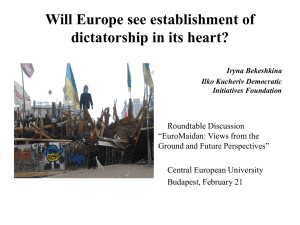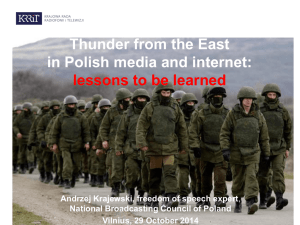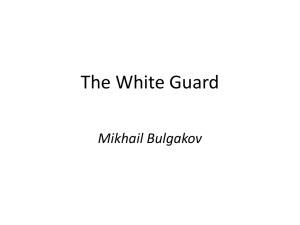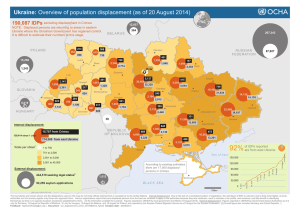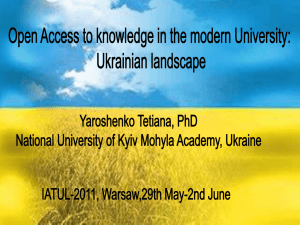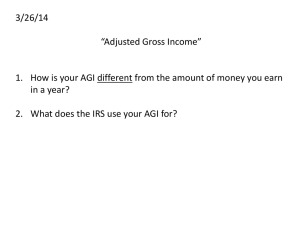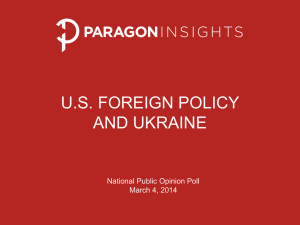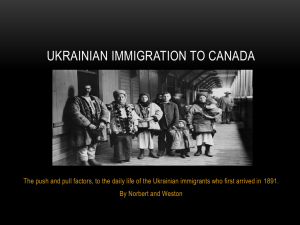Volodymyr Fesenko`s presentation
advertisement
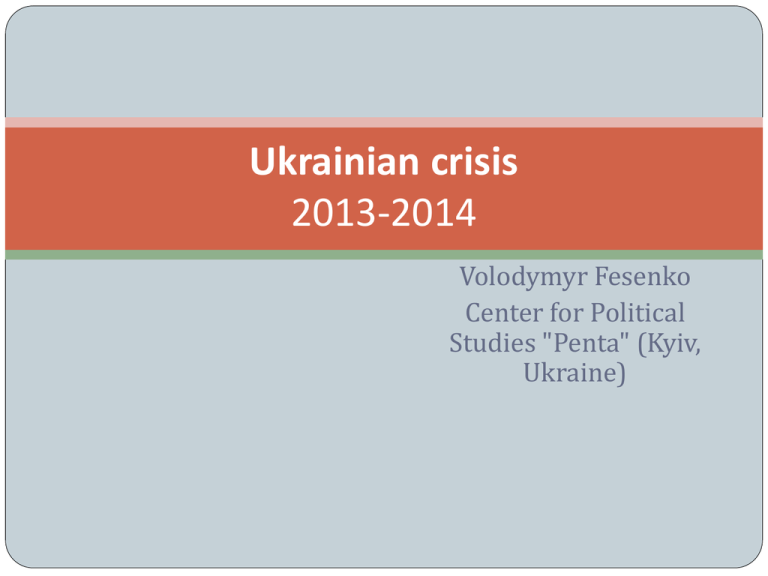
Ukrainian crisis 2013-2014 Volodymyr Fesenko Center for Political Studies "Penta" (Kyiv, Ukraine) Preconditions of new Ukrainian revolution Crisis of the post-soviet development model in Ukraine Significant ethnic and cultural diversity of Ukrainian society Tradition of mass political protests in Ukraine. Main causes of the crisis and revolution authoritarian trends strengthened systemic corruption enormous pressure on the private business deterioration of social standards crisis in economy growing discontent with Yanukovych regime Immediate reasons of the revolution sharp and unexpected turn in foreign policy when popular expectations were proEuropean; demonstrative use of violence against protesters (events of November 30th, 2013). Peculiarities of new Ukrainian revolution Center and a symbol of mass protests – Maidan (square downtown Kyiv) continuous massive protests with up to 200 thousand participants per day revolution started with peaceful protests which grew into street fights due to the use of violence by government More then 100 people died The revolution is proEuropean Collective coordination of the Maidan. Absence of one single leader. Driving forces of the revolution Socially active part of the middle class «Independence generation» Civil society: protest groups, social and political movements of Maidan. Three parliamentary opposition forces and nonparliament opposition political parties. Unsatisfied citizens from different social groups Social and demographic portrait of protesters. Beginning of the revolution 50% of participants come from Kyiv, 50% from provinces. Total majority (92%) are not members of any political party Maidan was younger then population of a country in general – average age 36 Men dominated over women insignificantly (56% against 44%) 64% had university degrees. Language structure corresponded with average in country. Social and demographic portrait of protesters at the last stage of revolution 88% are from province, 12% - from Kyiv. 55% come from Western Ukraine 84% of permanent Maidan participants came there independently, 13% belonged to groups organized by civic movements, 3% - by political parties. The majority of participants were not members of any social or political movements (70%) 88% - men, 12% - women; average age – 37 years 42% have higher education, 9% were students. Role of nationalistic radical movements in Maidan Nationalist movements constituted no more than one third of permanent participants of Maidan. Membership of the most known radical organization on Maidan (Pravyi sector) was no more than 500 people The problem was not in the influence of nationalistic organizations on Maidan but in radicalization of protests. In between December 2013 and February 2014 a percentage of supporters of creation of militarized units for resistance (on Maidan) grew from 21% to 50%. Goals (demands) of protesters December 7-8, 2013 December 20, 013 February 3, 2014 Resigantion of Yanukovych, early presidential elections End of repressions, amnesty for detained protesters Resignation of government 75,1 65,7 85,2 81.8 63,9 82,2 80,1 74,5 68,2 Criminal cases against officials responsible for use of violence against protesters Dissolution of Parliament and appointment of early parliamentary elections Return to the 2004 edition of the Constitution, which limits President;s authority Criminal cases against corrupt officials 57,6 50,7 63,7 55,6 51,4 59,1 37,9 42,8 62,5 49,6 42,8 62,1 Signing of Association Agreement with the EU Raising of social standards 71,0 58,6 49,0 46,9 42,5 41.1 Freeing of Yulia Tymoshenko 37.8 36,0 30,4 Potential challenges and threats Threat of dissolution of the country Possible separation of Crimea Severe economic conditions. Deterioration of economic situation due to pressure from Russia. Growing political instability Risks of Maidan anarchy during the first postrevolution months. Need for implementation of painful and unpopular reforms Internal consequences of revolution in Ukraine Systemic reset of power structures Existence of two power centers (new public administration and Maidan) during the first postrevolution months. Transformation of Ukrainian political system into parliamentary-presidential. Significant changes in the party landscape and change of political preferences of electorate. Attempt to conduct structural reforms External actors in Ukrainian crisis Russia The EU The USA Russian influence over Ukrainian crisis Political and economic pressure over Ukraine Significant economic support to Yanukovich(30% discount on gas; 15 bln USD loan) Persuading Ukrainian government to “establish order” including with military means. Development of counterMaidan projects on the level of local Russian speaking elites («Ukrainian front» etc.). Launch of scenario of separation of Crimea The US influence over Ukrainian crisis Prevention of violence Visa sanctions against particular Ukrainian officials, warning on upcoming financial sanctions role of the intermediary in the political negotiations Assistance in channeling financial support to Ukraine through IMF. Pressure on Russian leadership The EU influence over Ukrainian crisis The EU failed to make Yanukovych sigh Association Agreement and DCFTA. Belated reaction of the EU toward Ukrainian crisis during its first phase. Prevention of usage of violence by government of Ukraine Efficient mediation to stop bloody conflict and organization of negotiations between the government and the opposition Possibility of direct macroeconomic support for Ukraine. Pressure over Russian political management aimed at prevention of interference into internal affairs of Ukraine. Geopolitical consequences of the new revolution in Ukraine Ukraine is back on track in regards to the EU integration. Further tensions between Russia and Ukraine Possible international crisis over status of Crimea. Probable crisis of relations between Russia and the West due to political situation in Ukraine and Crimea. Ukrainian factor can influence situation in Eastern Europe and political situation in countries of Eurasian Union, in particular Belarus and Russia. Crimean crisis Russia launched scenario of separation of Crimea. Pro-Russian organizations in Crimea seized the power. Leader of political party «Rosiyskoe edinstvo» (Russian unity) Sergiy Aksionov appointed as the prime minister All air bases in Crimea are controlled by russian army It is military aggression, but without formal announcement of war Crimean Crisis. Scenarios 1) Rapid separation of Crimea from Ukraine after the referendum on the new status of the autonomy. 2) Russia establishes unofficial protectorate over Crimea, which formally continues to be a part of Ukraine. 3) Ukraine agrees on significant extension of autonomous status of Crimea and thanks to Western support and pressure over Russia makes Russian forces come back to their military bases. Crimean scenario is already used for other Eastern regions of the country to divide Ukraine and make new Ukrainian government illegitimate. Thank you for the attention!
